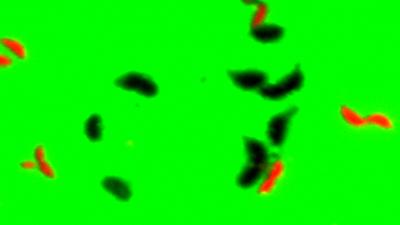A sweet bacterium keeps track of time

Caulobacter crescentus's cellular division produces different daughter cells, some with capsules (black cells) and some without (red cells). Credit: ©Ardissone_et_al, University of Geneva
Researchers are studying the Caulobacter crescentus bacterium because of its developmental process and cellular cycle, which serve as models for a number of pathogenic bacteria.
They all have in common the use of polysaccharides to create a particularly effective protective envelope, or capsule. Professor Viollier's laboratory at the University of Geneva's (UNIGE) Faculty of Medicine has just unraveled the secrets of capsule formation during the cellular cycle and perhaps even identified potential Achilles' heel of bacteria. These results were published in the last edition of the eLife journal.
Silvia Ardissone, researcher in the Department of Microbiology and Molecular Medicine at UNIGE's Faculty of Medicine, works with Caulobacter crescentus, a bacterium that shows a particularly interesting cell division.
In fact, as with eukaryotic organisms, division of Caulobacter cells generates two different daughter cells, which can be easily separated. Researchers take advantage of this feature to obtain populations of synchronized bacteria that can be used to study specific cell cycle processes.
The sugar capsule, typical of pathogens
Like other bacteria, including several pathogenic species, Caulobacter crescentus presents a capsular envelope made of polysaccharides (sugars). This envelope protects bacteria from viruses, as well as from the human immune system. Professor Patrick Viollier's team studies how cells produce the capsule at the right time and just identified some of the underlying regulatory mechanisms.
One of the daughter cells lacks the capsule
Of the two different daughter cells generated by Caulobacter at each cell division only one is equipped with the capsule. This is what scientists noticed, and now they can now explain the reasons behind such a difference. In fact, the researchers showed that the synthesis of the capsule is controlled by the same mechanisms that regulate the cell cycle, and identified the protein that inhibits the production of the sugar capsule in one of the daughter cells.
“An uncharted path seems to have opened for the development of a new kind of antibiotics, products that would imitate the action of this inhibitory protein,” comments Silvia Ardissone, who also imagines a type of medicine that “would strip the pathogens,” and therefore disarm an entire bacteriological spectrum.
Media Contact
More Information:
http://www.unige.ch/All latest news from the category: Life Sciences and Chemistry
Articles and reports from the Life Sciences and chemistry area deal with applied and basic research into modern biology, chemistry and human medicine.
Valuable information can be found on a range of life sciences fields including bacteriology, biochemistry, bionics, bioinformatics, biophysics, biotechnology, genetics, geobotany, human biology, marine biology, microbiology, molecular biology, cellular biology, zoology, bioinorganic chemistry, microchemistry and environmental chemistry.
Newest articles

Properties of new materials for microchips
… can now be measured well. Reseachers of Delft University of Technology demonstrated measuring performance properties of ultrathin silicon membranes. Making ever smaller and more powerful chips requires new ultrathin…

Floating solar’s potential
… to support sustainable development by addressing climate, water, and energy goals holistically. A new study published this week in Nature Energy raises the potential for floating solar photovoltaics (FPV)…

Skyrmions move at record speeds
… a step towards the computing of the future. An international research team led by scientists from the CNRS1 has discovered that the magnetic nanobubbles2 known as skyrmions can be…





















